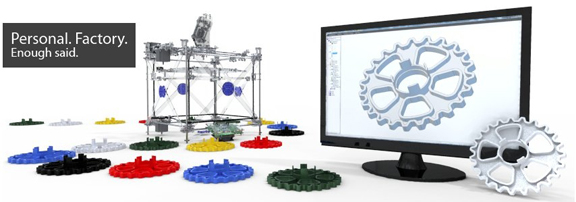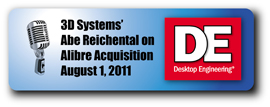Latest News
August 1, 2011
You might remember that, in May, rapid prototyping printer maker 3D Systems and CAD software maker Alibre struck up a partnership to bring you a RP-CAD bundle for as little as $1,500. It appears the partnership was just prelude to an acquisition.
Abe Reichental, president and CEO of 3D Systems, revealed, “There was already a deal in progress at the time we announced the marketing partnership in May. It was coincidental, in that our 3D printer channel manager approached Alibre to discuss and suggest a partnership, not knowing the two companies were already engaged in advanced acquisition discussion. So we just allowed [the marketing partnership] to happen organically.”
This month, 3D Systems bought Alibre Software, bringing an affordable CAD package into its portfolio. In the announcement, Reichental explained, “With Alibre in our portfolio we are personalizing and integrating design and manufacturing productivity. The combined affordability and user friendliness of our expanded 3D content-to-print solutions offer a clear and compelling choice for engineers, designers and makers to create and make instantly, at work and home.”
Beside traditional engineers and designers, Alibre also caters to hobbyists, tinkerers, homegrown inventors, and craft-fair traders with its Aliber Personal Edition ($199). One of the hurdles new users must overcome is Alibre’s parametric modeling tradition, well-known among long-time CAD users but not always easy to grasp for beginners.
Reichental said, “Classic parametric technology requires too much of a learning curve ... it excludes less expert users ... We believe there is room, there is space—particularly for the do-it-yourself users and garage entrepreneurs—to create a simple, intuitive CAD package for those audiences. And also for youngsters, kids in elementary, middle school, and high school ages to partake in this exciting 3D revolution.”
Direct modelers like SpaceClaim have had great success by allowing users to use Google SketchUp-style push-pull modeling methods to create 3D geometry, bypassing the need to learn parametric principles altogether. Other parametric software makers—Siemens PLM Software, PTC, and Autodesk, to name but a few—are revamping their own flagship CAD packages to include more direct-editing features.
Reichental wasn’t specific about how he plans to simplify Alibre software, but one possible approach may be to follow in the footsteps of rival packages like Siemens’ Solid Edge with Synchronous Technology, PTC Creo/Direct, and Autodesk Fusion to include more direct-editing tools. (Alibre offers push-pull modeling in its higher end professional package, but not in its low-cost Personal Edition.)
For Alibre software users, little change is expected, as Reichental plans to use Alibre’s own distribution channel and support network to keep the well-oiled sales machine going for the most part. “We’re very impressed with the quality of [Alibre’s] reseller channel ... we’re excited about their own online, outbound sales capability,” he said.
3D Systems’ grand plan is to “evolve Alibre from a company into a brand,” revealed Reichental, adding, “In our mind, we’re not in this to be CAD vendors. We’re here to offer design productivity tools. That will include some of the SYCODE plug-ins.”
India-headquartered SYCODE, which develops and markets plug-ins for major CAD packages, was founded by Deelip Menezes, who also maintains a blog about the CAD industry. In April, 3D Systems acquired Menezes’ company and gave him directives to establish 3D Systems India.
“We’re particularly excited about the opportunity to expand the field of use in bona fide education and consumer applications at entry level, and in full-fledged manufacturing applications on the high end,” said Reichental.
Part of the challenge in preparing 3D models for 3D printing is the need to strip out certain features or to adjust the geometry to make the mode fit for print (for example, increasing the thickness of wafer-thin walls so they can be printed without the risk of collapse). Bundling a consumer-level 3D printer with an easy, intuitive 3D editing software will go a long way in making 3D printing more accessible, especially in emerging markets where buyers usually don’t own or routinely use CAD software.
For more, listen to the complete audio interview with Abe Reichental.
Subscribe to our FREE magazine, FREE email newsletters or both!
Latest News
About the Author
Kenneth Wong is Digital Engineering’s resident blogger and senior editor. Email him at [email protected] or share your thoughts on this article at digitaleng.news/facebook.
Follow DE








